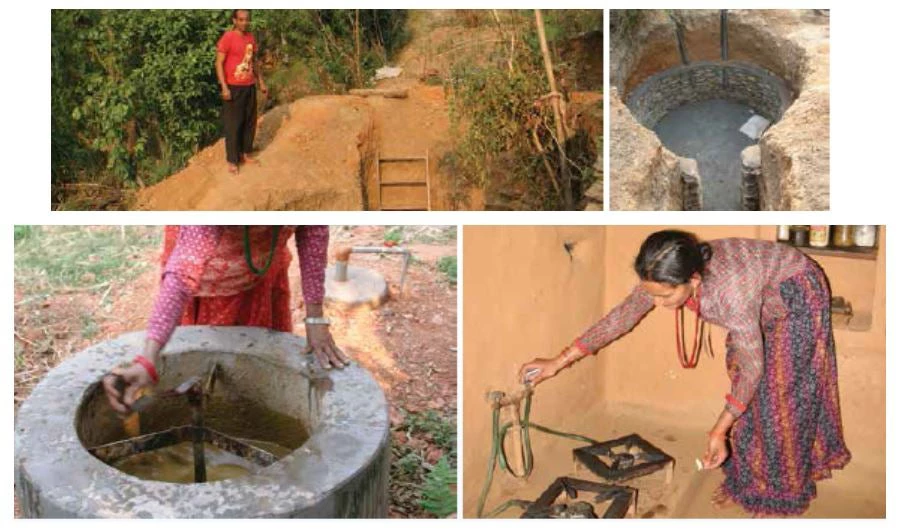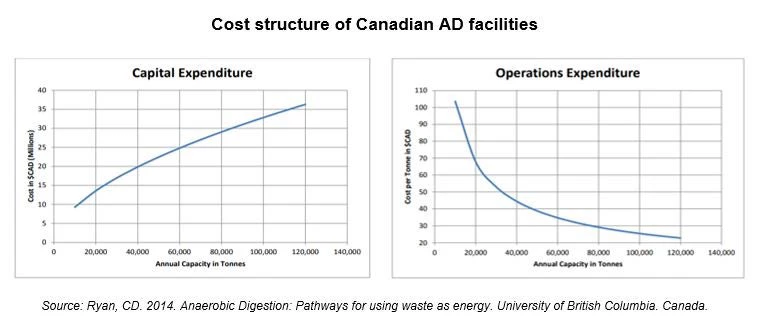What do Yucatan (Mexico), Michoacan (Mexico), Karur (India), and Jan Kempdorp (South Africa) have in common? These are all places with successful stories of implementing Anaerobic Digestion (AD) for wastewater treatment. But what is AD? What are the benefits?
AD systems are installed for many different purposes, such as a waste treatment step, a means to reduce odours, a source of additional revenues, or a way to improve public image. The AD treats water and waste, reducing adverse environmental impacts. Through AD, two main by-products can be obtained: biogas—that can be used as a fuel, and sludge—that can be used as a soil amender for improve crops. These AD “by-products” are important in the context of mitigating the impacts of climate change, where environmental co-benefits come from efficient use of “by-products”. For instance, livestock enteric fermentation, livestock waste management, rice cultivation, and agricultural waste burning are all sources of methane emissions, representing between 7 and 10 percent of global methane emissions. AD not only treats water through an environmentally sustainable approach, but also contributes to produce high rates of methane for recovery and further utilization.

AD is being implemented all over the world, but cutting edge research and technologies are improving the currently expensive AD infrastructures, while maximizing the treatment and minimizing the production of biogas—hence making new AD technologies with higher economic returns.
- In Karur, India, for instance, a large-scale beef-producing farm installed an AD facility to avoid GHG emissions (help control pollution from 1,800 cows) and generate carbon credits for the company and local community.
- In South Africa, the Jan Kempdorp Abbatoir site uses an AD system to address cattle and bovine wastes to reduce GHG emissions, improve the elimination of animal by-products, reduce power grid demand by producing onsite energy, and create jobs.
- In Yucatan, Mexico, a novel approach merges water treatment and methane reduction, while promoting reforestation. This initiative installed 13 wastewater management systems for 44 swine farms. The systems were equipped with anaerobic digesters, solid separators, forest plantation areas, and a storage lagoon. The systems utilize the effluent as a source of water and nutrients for the forest plantations. Additionally, these systems capture and produce biogas energy, which is used to supply electricity to all the farms.
- The facility located in Michoacan, Mexico, operated by NOPALIMEX is the first AD plant in the world which uses cactus waste as a biomass source for biogas production. They use the biogas as a fuel for the local`s vehicles, who enjoy the benefits of a cheaper and environmentally friendly fuel.
Researchers and environmental consultancies are promoting the “biogas culture”, encouraging people of poor communities to use their whole spectrum of organic wastes (manures, gardening, kitchen, or human faeces) to be treated by small-networks of anaerobic digesters. These tendencies are focusing on scaling up these solutions and educating the rural population about the importance of renewable energy and the benefits of collecting and taking advantage of the by-products released through AD processes.
AD costs are much lower compared to that of other technologies. Depending on the country, the cost of the materials to build an anaerobic digester can be from USD $35-100. In larger markets, some companies in low income countries have developed a wide range of supplementary items that use AD by-products, such as lamps, stoves, and power-generating plants. However, their price, despite being lower, represents an extra investment that the people in rural areas may not be able to afford. On social media some people have shown skilled and creative ways to build items for by-products and (re)use with recyclable materials that can help to reduce AD’s unit costs, while providing the best usage to the biogas.

The simplicity of usage of the AD and the warm weather in Latin America are key factors that can change life in rural communities. The biogas production and waste treatment is better when the temperatures are high and would allow to get a fuel for cooking or boiling water, produce energy, and, at the same time, treat wastes, obtaining an odourless slurry, rich in nutrients, which can be used for irrigating crops or gardens.
Nevertheless, the large increase of AD installations and capacity is largely driven by regulatory and policy incentives. Development organizations and practitioners must work closely with governments to design, promote, and implement these types of technologies.



Join the Conversation